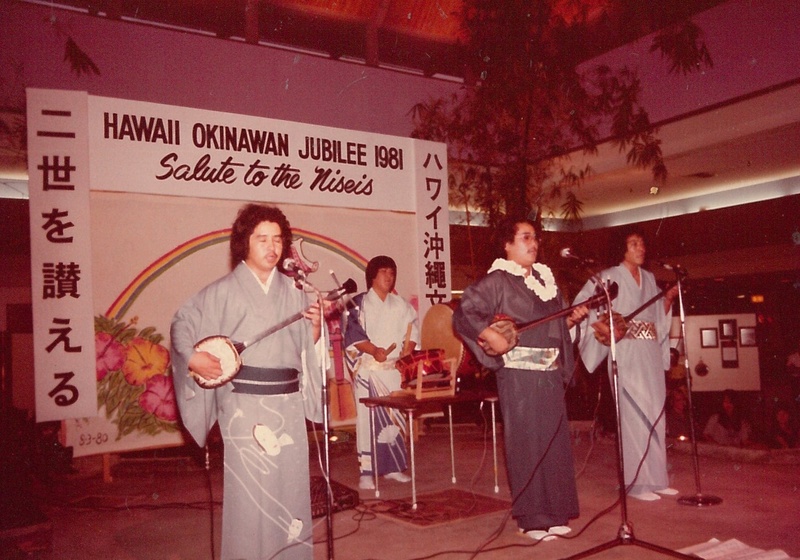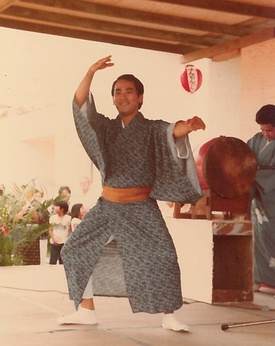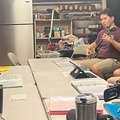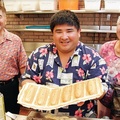Up until Grant’s divorce and his son’s illness, for about 30 years, he remained unaware of his Okinawan lineage. He was raised by Japanese-American Sansei parents, and never wondered why he so passionately gravitated toward Okinawan culture: as a 13-year-old, he wanted to practice Okinawan dance and play sanshin; he loved listening to Issei and asking them questions; he even took to Uchinaaguchi (Okinawan language).
Mrs. Terukina asked him “Who are you?” to urge him to seek out his birth parents. Grant always resisted seeking out his birth parents because he didn’t feel it was appropriate to do so when he had been raised with so much affection by his adoptive parents.
The starting point for Grant’s search for his mother began at the Hawaii State Family Court to see if they had his adoption records. He was told that a letter would have to be sent to the address they had on file, from over 30 years ago, to his birth mother to receive her permission to release his records to him. After feeling that the Family Court was of no help, he contacted an organization called the “Adoption Circle of Hawaii.” They acknowledge Grant's frustrations with Family Court and also pointed out that in the “old days” there were typically a lot of mistakes on adoption paperwork.
One night, the name of his birth mother was finally revealed to Grant. He recalls an evening when the electricity went out, “There was a blackout, and while I sat in the dark with my parents, I asked my dad if he had any information about my birth mother.” At first, Clarence denied he had any idea who Grant’s birth mother was. So Grant just went to his room to rest, and a few moments later, his father came to his room and handed his son a small crumpled piece of paper. Written on the paper was the name “Darlean Tamayoshi.”
Grant decided to contact the Hawaii United Okinawa Association to inquire about Darlean Tamayoshi. Since the spelling of “Darlean” wasn’t the more common “Darlene,” he was advised to try calling one of the club’s members Darlean Kiyokane. Her mother’s name was Jean Chiyoko Tamayoshi. Grant was able to get Mrs. Tamayoshi’s phone number and gave her a call. He asked if she had a daughter Darlean. Mrs. Tamayoshi wanted to know why, so Grant told her that she might be his birth mother. Mrs. Tamayoshi denied the possibility profusely. But, before hanging up, she asked for Grant's birthdate.
When Darlean heard about the news, she knew Grant had to be her son, but it took a while for her to be ready. Grant also admitted to her that he wasn’t sure he’d ever get to a place where he could call her “Mom.” However, the two began a relationship that included a shared joy for Okinawan culture. They talked about how many times (maybe hundreds) they must have been in the same room when there were events or club meetings at the Hawaii Okinawa Center in Waipio.
Darlean even started to take Okinawan dance lessons and became more involved in the Okinawan community. These choices were now made with a new purpose enriched by a new bond. Darlean said that April, the month she gave birth to Grant, had now become a joyful month after what used to be many annual recurrences of sadness.
Perhaps this aspect of Grant Murata’s life is the reason why he has the unique ability to treat people like family. His love languages vary from serving you homemade food at his home to telling it straight to your face that you’re not acting with honor or respect.
People close to him know that he can get his feathers ruffled sometimes, but it comes from his belief that he wants what’s best for his students, he wants what’s best for the performing arts community and that he will waste no time in planting as many seeds as he can in his lifetime. He can be sure there might be a few good trees to carry on his legacy that was planted by his sensei (Choichi Terukina) who’s legacy was planted by his sensei (Haruyuki Miyazato) – first rooted centuries ago, and moving into future generation, perhaps centuries into the future.
ROOT TO RISE!
Grant Murata today, is 61 years old. For 30 of those years, he had no knowledge of being Okinawan. Yet, for ALL of those years, his ancestral DNA guided him on the path of a master uta-sanshin performing artist. What might have been perceived as quirky or weird has earned him reverence and respect, even among his uta-sanshin master peers in Okinawa. He is the first and only uta-sanshin master outside of Okinawa to judge the certification exams for the Afuso Ryu Gensei Kai held in Okinawa annually.
Listing his accomplishments will fill pages; the reach of Afuso Ryu is worldwide; and most importantly to Grant, the branches of his tree are flourishing with young students, many who travel to Okinawa to pursue vigorous training and certifications and eventually have students of their own. In fact, he states that his hope for all his students is: “Even if it’s just one person, (my) student should take on (their own) students; experience teaching whether it’s to young ones or family members.”
Tom Yamamoto, a vice-principal at Iliahi Elementary School, has been a student of Grant’s for about three decades. He said, “Masanduu Sensei has always inspired me to constantly improve in my learning and teaching skills, and he pushes me to attain higher levels of uta-sanshin, whether it’s increasing my repertoire of songs or taking the next level of certification. I would like to believe that he recognizes my abilities, which I assume is why he lets me teach the beginner classes, even if I don’t have the teaching certification, and also allows me to perform alongside him and the other sensei for jikata for various performances.
“It was because of Sensei, that I – and many of our members – were given the opportunity to learn directly from our sanshin master Choichi Terukina. It’s a rare occurrence that anyone living so far away from Okinawa can say that they have trained directly under their master instructor. I sincerely appreciate his dedication to his students and the knowledge that he has passed down to all of us. Aside from learning songs to perform, we are taught history and experiences related to each song.”
After retirement, Cassie Nakagawa became Grant’s student. In recent years, Cassie has earned her first and second level certifications (Shinjinsho and Yushusho). Grant’s teachings have helped her to deepen her bond with her heritage by teaching the stories behind the songs that she learns. She adds, “By the way, he is a great chef. His Okinawan cuisine exposed me to healthier dishes like goya champuru (a bittermelon stir-fry dish), chive tempura and nabera (a dish made from a loofa variety of squash). This inspired Neil and I to grow and cook healthier foods.”
Another student, Julia Nakasone Okamura is an Okinawan dance instructor whose mother, the late Yoshiko Lynne Nakasone, was one of Hawaii’s premier Okinawan dance instructors and has the largest Okinawan dance academy in Hawaii. Grant is known to push his students out of their comfort zones, Julia shared her experience of being challenged by him:
“Getting my sanshin shinjinsho was never on my radar, or in my wildest dreams. I started taking sanshin from Sensei because I wanted to learn more about songs and the meanings of the songs that I dance. I was very satisfied with my sanshin practices, however with Sensei’s support and encouragement I took my sanshin learnings to another level. Taking lessons from Sensei has had a positive impact in my life as a performing artist.”
On November 17, 2018, Grant Sadami “Masandu” Murata held the first-in-Hawaii solo performance by a master uta-sanshin performing artist. He was basically ordered by Grandmaster Terukina Choichi to put on the performance as a rite of passage. That year also happened to be the 150th anniversary of the Gannenmono, or “first year people.” The Gannenmono were pioneers who traveled to Hawaii in the first year of the Meiji era in 1868 and became Hawaii’s first Japanese immigrants. A life-long friend and student, the former Consul General of Japan in Hawaii who worked hard to set the foundation of the Gannenmono celebrations in Hawaii encouraged Grant to hold his solo performance in the anniversary year of the arrival of the Gannenmono.
In a letter to attendees of the solo performance titled “Hou On Sha Toku” he wrote. “It is amazing to reflect on how far we have come since the Gannenmono set foot on these islands into the unknown. Fear from uncertainty can turn into commitment and then perseverance. My journey into the unknown started when I decided to learn the Afuso style of uta-sanshin when it was non-existent in Hawaii.”
This first-in-history solo performance in Hawaii is another step up in the rise of Afuso Ryu in Hawaii. Hundreds came to celebrate Grant’s milestone performance that included classical and folk style uta-sanshin with dance and storytelling.
True to the Afuso legacy of growing branches, Grant’s student Kenton Odo held his solo performance as a master in uta-sanshin in the summer of 2022. This master student also led the coordination of making Choichi Terukina’s dream come true by executing a stage performance at Carnegie Hall in New York City on April 18, 2019. Afuso Ryu students and their friends and family all made the trip to participate on- and backstage. This also marked the 88th birthday of Grandmaster Terukina.
Grant Murata continues to share his Hawaii Okinawan culture with aloha, wisdom, food and talent with all those fortunate enough to cross his path. Traditional and innovative are some of the hallmarks of Afuso Ryu. Grant’s students’ are not only students who learn, but who teach. Humanity and compassion come from mutual understanding. Perhaps this is why music (and food) are universal languages that Hawaii’s Afuso Ryu students use to communicate by learning AND teaching. Don’t just be a “hanbi”; plant lots of seeds and maybe a few good trees will grow.
UYA NU MAGUKURU
NASHIGWA KUTU UMUTI USUMIJI YA NUDIN
UMURU MAMANARAN SHIKE NU NAREYA
UYA NUMAGUKURU WASHINNAYO WAGA NASHIGWA
FOR THE SAKE OF MY CHILDREN,
I WILL DRINK THE BRINY OCEAN
TO KEEP THEM FROM LIFE’S BITTER SWELLS.
OH BELOVED CHILD, LOVE GIVEN TO YOUR PARENTS’ WILL COME FROM YOUR CHILDREN.
*This article was originally published in the Zentoku Foundation website.
© 2024 Jodie Chiemi Ching








